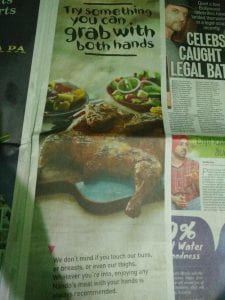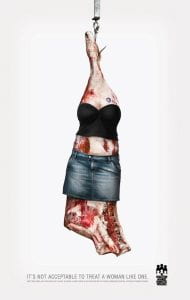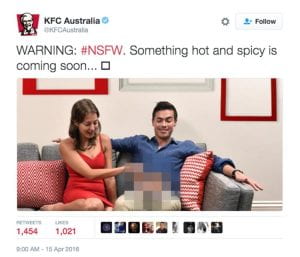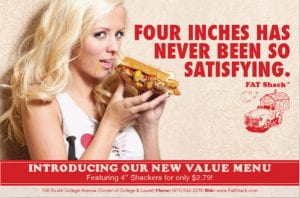
This is a photo that I took from Carol Adams photo library that holds examples of the sexual politics of meat. This photo in particular plays with double entendres surrounding meat and the social construct of sexual consent. This ad for Nando’s resturant places themselves as the alternative to a woman who is offended when they are sexully touched. Nando’s is essentially indicating that that social boundary is not found at their restaurant. While obviously substituting an actual woman for food in an anthropornographic context. Anthropornography is defined by Adams in an interview as she explained that “Anthropornography means animals (usually species of animals presumed to be literally consumable) are presented as sexually consumable, in a way that upholds the sexual exploitation of women” (Pots 14). In this picture the animal in question is the depiction of Nando’s chicken. This ad challenges the social construct of consent playing with the boundaries set by women by using their chicken as a replacement to be violated. The ad says “We don’t mind if you touch our buns or breasts or even our thighs whatever you’re into enjoying Nando’s meal with your hands is highly recommended” encouraging physicality towards and insinuating that the chicken is a sexual being.

This photo is a statement piece. Animalization and sexualization of animals are topics that Adams addresses in the interview with Annie Pots. Adams breaks down this construct describing how “They are working to maintain important aspects of consumer culture, to reinforce privilege by defining who is the consumer and who is the consumed” (Pots 15). The feminization of animals allows for domination and consumption. This piece draws attention to the dehumanization that women feel when looking at these sexualized ads that have no intention other than to cater to heterosexual men’s egos. The fact that this is the way in which we have almost standardized the way that we sell meat is uncouth and damaging. Sexualizing meat is acceptable because it’s “just chicken” or “just a joke” but it is still damaging for women, especially young women who are surrounded by this on a daily basis. Simply put we have built a system that casually pets the ego of men while devaluing women simultaneously all for the sake of advertising.

This ad also follows along with Adams description of the sexual politics of meat. This ad while not depicting meat is still intended to sell meat using sex. By playing on the “hot and spicy” double entendre they are able to make a “joke” and engage their male audience. It is clear that KFC is only interested in the male audience due to the male being the only one getting sexual gratification in the image. “Hot and spicy” could have been represented in both party’s engaging in sexual activity where the pleasure would be mutual. Yet, that is not the path KFC decided to follow. This ad plays on sexuality and the human need for sexual release to sell chicken equating the want for sex with the want for chicken on multiple different fronts. Yet, in the photo chosen again it is important to recognize that the sexual release is one sided. Adams dictates in the interview with Annie Pots how “the assumption of a white male perspective as universal and an appropriation of female bodies for male prerogatives” is pervasive and specifically represented in this ad (Pots 15).

This image while not directly an image of anthropornography still has the same intent. Here we see a woman who is depicted as innately sexual. The phrase “four inches has never been so satisfying” is an obvious joke indicating penis size and how all women want a big dick. These ads represent women as sexually insatiable animals, Adams speaks on the subject saying that “Such ads, suggest that not only do women promiscuously want sex, but the same desire is applicable to others in the ‘Not A’ category – nonhuman animals” (Kemmerer). It is dehumanizing to be reduced to a sexual object weather human or animal it takes away all value that is not sexual and intended to please others. We are constantly stripping animals and women of their agency and respect when we continually objectify and reduce them to sexual objects.

Hi Liz – I especially like the images that you have chosen from Carol Adams’ collection. In the vast collection that Adams has amassed for review, the ones you choose are sadly, too good a representation of the over-sexualized correlation between women and meat. The ad for Nando’s is most alarming to me. As I type that, I think that what I find to be alarming is that a company paid an advertising agency to come up with a way to sell chicken, and this was the socially acceptable result. The verbiage itself, should have cause someone along the way to do a double-take. Spelling out that it’s not only acceptable, but encouraged, to grab whatever part of the chicken (referenced to sexualize women as well) one likes shows our societal de-sensitization to the way in which both women and meat are constantly sexualized.
The KFC ad plays to a different and yet, just as direct aspect of sexualization. It is literally using sex to sell the spicy chicken, and as you point out, does so from a purely patriarchal standpoint. As Adams discusses, “As MacKinnon explains, “To be a means to the end of the sexual pleasure of one more powerful is, empirically, a degraded status and the female position” (2005: 129)” (“The Politics of Carol J. Adams,” 2010, 15). Clearly this ad, targeted to men, alludes to their sexual satisfaction as paramount, and the subservient actions of the woman as an afterthought. It degrades females as it prioritizes the power that men exert when their sexual needs take precedence, at any cost. Not that I am endorsing we use one wrong to right another, but as a social experiment, it would be interesting to see what ads would look like if the general tables were turned and women’s pleasure was the driving force behind ads. Would it be done at the expense of degrading men and animals? What would the effectiveness be and how would it translate to sales? It would also be interesting to see the data on current ads, how they translate to sales, and if there are more men buying products from sexualized ads. Just some food for thought!
Through the learnings of this week’s lesson, I have come to look at companies and their advertising with a layer of questioning that I didn’t completely assert before. I have the choice to vote which brands I endorse and who I give my monetary vote to. In looking at some of the downright, despicable ads from companies that have consciously chosen to sexualize women, I will be thinking twice about putting my money where my values are, or aren’t. What was one of your largest or most surprising learns from this week?
The Politics of Carol J. Adams. (2010). Antennae, 14, 12–24. https://static1.squarespace.com/static/54792ff7e4b0674c74cb719d/t/55dc8dace4b0ad76d7277cb7/1440517548517/ANTENNAE+ISSUE+14.pdf
Liz,
In another one of my WGS classes we skimmed the surface of advertising and how women are utilized. So this week’s Adam’s readings and assignments really came full circle. I think anthropornography plays a significant role in advertisements marketed toward women. Your description of anthropography was really awesome. Were you at all shocked at the lifespan of this style of marketing? There are so many of these images that I looked at, examined and shook my head in shock. The notation of consent is not present in any of these images and to your point consent is placed on the backburner when women are used in this way in advertisement. Adam’s seventh point about anthropology is that, “Anthropornography naturalizes sexual trafficking in and use of women ” (Adams 13). To make a comparison between the two is centered at both of these things ( are violence against women and lack of consent are all forms of oppression that women face directly and indirectly.
Hi Liz – I’m glad to see that you analyzed the ‘meat hook’ photo. I almost selected this one as well, so I was interested to see another perspective. I looked at it a little differently – I saw it as slightly hypocritical without even realizing that it was. I think the underlying meaning of it is positive – it is meant to be supportive of women and how they are treated by a lot of men. The general message is well-meaning and sparks and important conversation about the daily treatment women face in the world, and that they shouldn’t be treated like ‘pieces of meat’. But the ‘pieces of meat part’ is what catches me after all we have learned in this class. It implies that meat deserves to be treated as such, and to stay in a place of oppression. But just like we cannot step on others to make ourselves feel better, we shouldn’t participate in oppression to help stop oppression.
I had to chuckle at your last image (‘four inches’) and your interpretation of it – great take! On this one, I’m not even sure who this one is targeting. What many of these photos we looked at seem to have in common is that they tend to degrade someone in some form or other. It’s targeted towards one group, while stepping on or putting down another. It does seem to be oversexualizing women, but the ‘four inches’ part seems to degrade men as well. While men are expected to have great sexual prowess and huge penises, this implies a dig at men who have allegedly small penises, and that they can ‘finally’ satisfy a woman. Especially one who is as objectively beautiful as the one in the picture. I think your take is accurate as well, but thought this had an interesting twist to it!